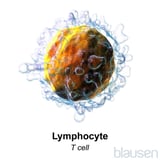Blue Color of the Skin andor Mucous Membranes
Mucous membrane pemphigoid is an autoimmune disorder that causes blisters to form in the mucous membranes of the body. The mucous membranes most often affected are the mouth and eyes.
-
Mucous membrane pemphigoid occurs when the immune system attacks the mucus membranes and causes blisters and sores.
-
People have blistering in the mouth and on other areas of the body.
-
Doctors diagnose mucous membrane pemphigoid by examining tissue samples under a microscope.
-
Treatment usually involves corticosteroids or drugs that suppress the immune system.
The body's immune system Overview of the Immune System The immune system is designed to defend the body against foreign or dangerous invaders. Such invaders include Microorganisms (commonly called germs, such as bacteria, viruses, and fungi) Parasites... read more makes special cells that protect the body against harmful foreign invaders such as bacteria and viruses. Some of these cells respond to invaders by producing proteins called antibodies. Antibodies Antibodies One of the body's lines of defense ( immune system) involves white blood cells (leukocytes) that travel through the bloodstream and into tissues, searching for and attacking microorganisms and... read more  target and attach to the invaders and attract other cells in the immune system to destroy them. In an autoimmune disorder Autoimmune Disorders An autoimmune disorder is a malfunction of the body's immune system that causes the body to attack its own tissues. What triggers autoimmune disorders is not known. Symptoms vary depending on... read more , the body's immune system mistakenly attacks the body's own tissues—in this case, the skin. The antibodies that are produced mistakenly target the tissues as invaders, which makes them susceptible to destruction. In mucous membrane pemphigoid, the antibodies react with the mucous membranes of the mouth (or other mucous membranes), which blister and break down, forming open sores (ulcers).
target and attach to the invaders and attract other cells in the immune system to destroy them. In an autoimmune disorder Autoimmune Disorders An autoimmune disorder is a malfunction of the body's immune system that causes the body to attack its own tissues. What triggers autoimmune disorders is not known. Symptoms vary depending on... read more , the body's immune system mistakenly attacks the body's own tissues—in this case, the skin. The antibodies that are produced mistakenly target the tissues as invaders, which makes them susceptible to destruction. In mucous membrane pemphigoid, the antibodies react with the mucous membranes of the mouth (or other mucous membranes), which blister and break down, forming open sores (ulcers).
The major symptom of mucous membrane pemphigoid is the development of painful blistering that causes redness, swelling, and breakdown of the mucous membranes, eventually forming open sores (ulcers). As they heal, these ulcers may cause scars to form in the affected area. People rarely see actual blisters, and typically see only the raw, worn away areas.
In the mouth, blistering typically involves the gums and anywhere along the lining of the mouth. The inside of the cheeks, the gums, and roof of the mouth are red and sore. Wearing down of the mucous membranes causes ulcers that burn or sting.
In other mucous membranes, such as in the nose, down the throat, or on the surface of the genitals and anus, the ulcers heal, often with scarring. Scarring can cause the lining of the esophagus (the tube that connects the throat to the stomach) to become narrow, which makes swallowing difficult.
In some people with mucous membrane pemphigoid, actual blisters form on the skin. They tend to appear on the scalp, face, trunk, or limbs. The skin typically scars once the blisters heal.
-
Biopsy
Doctors usually recognize mucous membrane pemphigoid by its characteristic appearance. The disorder is diagnosed with certainty by examining a sample of tissue under a microscope (biopsy). Sometimes doctors use special chemical stains that allow antibody deposits to be seen under the microscope (called an immunofluorescence assay).
Mucous membrane pemphigoid progresses slowly, rarely goes away without treatment, and often does not go away completely with treatment.
Some people who have mucous membrane pemphigoid have an increased risk of internal cancer.
-
Corticosteroids and doxycycline plus nicotinamide
-
Sometimes other drugs, including immunosuppressants for people with severe disease
Treatment of mucous membrane pemphigoid includes corticosteroids and a combination of doxycycline and nicotinamide taken by mouth. The corticosteroids may be applied directly to the affected area or may be injected into the sores.
People who have severe mucous membrane pemphigoid may need drugs that suppress the immune system (immunosuppressants), so dapsone or prednisone may be given. Or sometimes people are given high doses of prednisone in addition to other immunosuppressants (such as azathioprine, mycophenolate mofetil, rituximab, or cyclophosphamide) and immune globulin given by vein (intravenously).
The following is an English-language resource that may be useful. Please note that THE MANUAL is not responsible for the content of this resource.
CLICK HERE FOR THE PROFESSIONAL VERSION

Copyright © 2022 Merck & Co., Inc., Rahway, NJ, USA and its affiliates. All rights reserved.
Source: https://www.merckmanuals.com/en-pr/home/skin-disorders/blistering-diseases/mucous-membrane-pemphigoid
0 Response to "Blue Color of the Skin andor Mucous Membranes"
Post a Comment